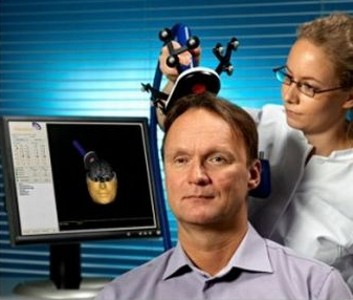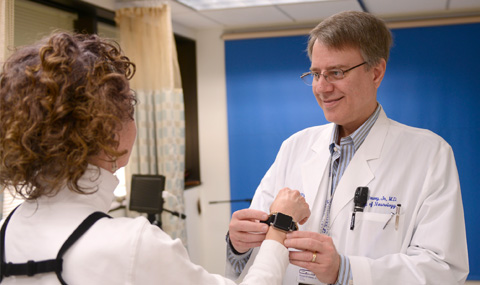.gif) VIARTIS � |
|||||||||||||||||||||
|
PARKINSON'S DISEASE |
|||||||||||||||||||||
| � � |
|||||||||||||||||||||
|
� � � � |
PARKINSON'S DISEASE NEWS � |
� � � � � � � � � � � � � � � |
|||||||||||||||||||
|
FEBRUARY 2015 � 26th February 2015 - New books ENCYCLOPEDIA OF PARKINSON'S DISEASE (8 volumes) Kate White
Encyclopedia of Parkinson's Disease is an 8 volume series of encyclopedias covering all different aspects of Parkinson's Disease including : etiology, pathphysiology, clinical aspects, diagnosis, rehabilitation, models and modules, therapeutics, novel treatments, advanced therapies. It is certainly the most extensive encyclopedia of Parkinson's Disease.
For more books concerning Parkinson's Disease go to Parkinson's Disease books In order to refer to this article on its own click here � 23rd February 2015 - New research EFFECT OF RESISTANCE TRAINING ON PARKINSON'S DISEASE
Resistance training is any exercise that causes the muscles to contract
against an external resistance with the expectation of increases in
strength, tone, mass, and/or endurance. The external resistance can be
weights, dumbbells, your own body weight, or any other objects that are
heavy enough to cause the muscles to contract. For more information go to
:
Resistance training This review demonstrated that moderate intensity progressive resistance training, 2 to 3 times per week over 8 to 10 weeks, can result in significant strength, balance and motor symptom gains in people with early to moderate Parkinson's Disease. Reference : Clinical Rehabilitation [2015] Feb 17 [Epub ahead of print] (C.L.Chung, S. Thilarajah, D.Tan) Complete abstract� In order to refer to this article on its own click here � 19th February 2015 - New research EFFECTS OF TRANSCRANIAL MAGNETIC STIMULATION ON PARKINSON'S DISEASE
Repetitive transcranial magnetic stimulation (rTMS) is a non-invasive
technique that relies on electromagnetic induction using an insulated coil
placed over the scalp. The coil generates brief magnetic pulses, which pass
easily and painlessly through the skull into the brain. When pulses are
administered in rapid succession, it is referred to as "repetitive TMS" or
"rTMS", which can produce longer lasting changes in brain activity.
For
more information go to :
Transcranial magnetic stimulation
�However, results evaluating the effectiveness of rTMS in
Parkinson's Disease are mixed. So an assessment was made of all studies
concerning the use of rTMS in Parkinson's Disease. Reference : JAMA Neurology [2015] Feb 16 [Epub ahead of print] (Y.H.Chou, P.T.Hickey, M.Sundman, A.W.Song, N.K.Chen) Complete abstract� In order to refer to this article on its own click here � 18th February 2015 - New book PARKINSON'S DISEASE (DISEASES AND DISORDERS) Lizabeth Craig
� 14th February 2015 - New research ELTOPRAZINE REDUCES DYSKINESIA IN PARKINSON'S DISEASE
Eltoprazine has been found to reduce L-dopa induced dyskinesias in
Parkinson's Disease. Eltoprazine is a 5HT partial agonist being developed by
Amarantus for the treatment of L-dopa induced dyskinesias in Parkinson's
Disease, Attention Deficit Hyperactivity Disorder and Cognition.
Simultaneous activation of 5-HT1A and 5-HT1B receptors effectively blocked
L-dopa induced dyskinesias in animal models, thereby suggesting its use in
humans. For
more information go to :
Eltoprazine
� Reference : Brain [2015] Feb 10 [Epub ahead of print] (P.Svenningsson, C.Rosenblad, K.Af Edholm Arvidsson, K.Wictorin, C.Keywood, B.Shankar, D.A.Lowe, A.Bj�rklund, H. Widner)� Complete abstract� In order to refer to this article on its own click here � 11th February 2015 - New research APDM MOBILITY LAB FOR PARKINSON'S DISEASE ASSESSMENT
The diagnosis and estimation of disease severity in Parkinson's Disease was
assessed using the APDM Mobility Lab. The APDM Mobility Lab uses wearable
sensors and sophisticated signal processing to track even subtle changes in
gait, stride, balance, rotation, and efficiency and range of movement in
upper and lower limbs and torsos. Sensors are simply strapped on to the
subject on various parts of the body, including the chest, waist, wrists and
ankles. Subjects then perform a test after which a report is generated. For
more information go to :
APDM Mobility Lab
� The study identified sets of iTUG and iSway variables that correlate with Parkinson's Disease severity measures and differentiate people with Parkinson's Disease. The authors suggest that these gait and balance measures could therefore potentially serve as markers of Parkinson's Disease progression. They are consequently under evaluation for this purpose in the ongoing NIH Parkinson Disease Biomarker Program. Reference : Journal of Neurological Science [2014] 345 (1-2) : 131-138 (D.C.Dewey, S. Miocinovic, I.Bernstein, P.Khemani, R.B.Dewey, R.Querry, S.Chitnis, R.B.Dewey Jr)� Complete abstract� In order to refer to this article on its own click here �
��
|
|||||||||||||||||||||
| � | |||||||||||||||||||||
.gif) |
|||||||||||||||||||||
| � | |||||||||||||||||||||
| �2006-2015 Viartis | |||||||||||||||||||||
| � | |||||||||||||||||||||
| [email protected]� | |||||||||||||||||||||



.jpg) Publisher's
description : This title in Lucent's Diseases and Disorders series focuses on
Parkinson's Disease. The book describes how the disease is contracted, its
symptoms, and treatments. It also discusses the issues that caregivers face.
These books offer readers a means of understanding various ailments; clear,
careful explanations offer insight into what these conditions are, what causes
them, how we cope with them, and the latest information about treatment and
prevention. All volumes in the series include primary and secondary quotations,
annotated bibliographies, detailed indexes, and lists of organizations to
contact for additional information
Publisher's
description : This title in Lucent's Diseases and Disorders series focuses on
Parkinson's Disease. The book describes how the disease is contracted, its
symptoms, and treatments. It also discusses the issues that caregivers face.
These books offer readers a means of understanding various ailments; clear,
careful explanations offer insight into what these conditions are, what causes
them, how we cope with them, and the latest information about treatment and
prevention. All volumes in the series include primary and secondary quotations,
annotated bibliographies, detailed indexes, and lists of organizations to
contact for additional information

